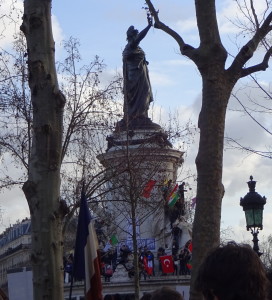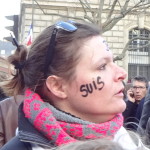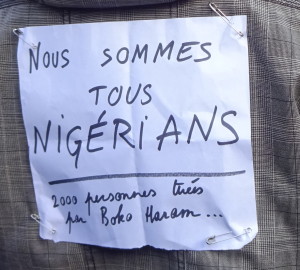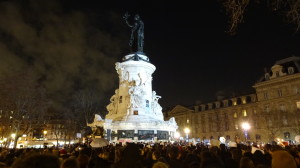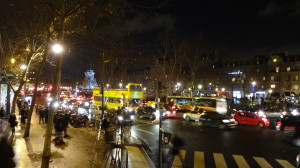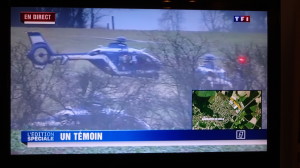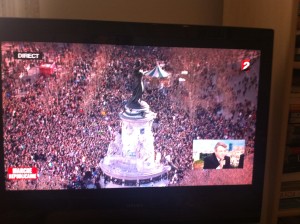It had been announced that all transport was free. But the 96 bus wasn’t running. And in the Metro the platforms were crowded. Train after train went past, and still we couldn’t get on. Finally we joined the crush in a carriage. Some firm women by the door stopped others coming in as we seemed to crawl to Odeon, St Michel, Cite. We got out at Strasbourg Saint Denis, but it was impossible to leave by the Sortie on the platform. Everywhere were people, posters and flags in their hands ready to furl, ready to lift. Eventually we arrived in Boulevard St Martin. It was 2.30 and people were filling the streets in their thousands. There was chanting, occasional bursts of cheering, clappping. There was no internet connection and no phone connection.
We squeezed into Place de la Republique at 3pm. It was packed. Marchers, police vans, media vans, everyone with a phone, waving their arms trying to take a picture. The other roads leading into the Place were also heaving with people. The call had gone out for everyone in France to demonstrate, and it felt as if they were all here, in one square in Paris. People were clinging to lamp-posts, little children sat on their parents’ shoulders, friends clutched the arms of each other, a man murmured to someone who looked like his dad, ‘Don’t worry, I’ve got you.’ Others had clambered up onto the statue in the centre. People leaned out of the windows. Banks of photographers stood on balconies.
And so many people were holding cards, posters, signs. They held them for hours.
‘Je veux marcher!’ a woman said to me, but there was no question of marching. We moved forwards and sideways. It did feel to an extent that this was a demonstration of despair, people wanting to express their horror at so much of what is happening in the world, and solidarity with all those affected by injustice.
Apart from a few sirens, there were very few police (visible) and people joked that they were all protecting the government leaders from across the world, the leaders who had come to – to do what? Show respect? Join in? Score political points? Did they stand for hours, crushed, blocked, pushed into mud, waiting to move, did they hold placards in the air?
Leaving the Place was almost as difficult as getting there. Every street was filled with people, now going both ways. There were no buses, a few motorbikes tried to push their way through, but the roads were full of people. We had an arrangement to see some friends for dinner but getting home to change and getting back to them seemed an impossibility. And still there was no internet or telephone connection! We stood pathetically outside their door near Arts and Metiers. There was no-one. We were swirled along by the crowd down to the Pompidou Centre, and then came a text. Come to us now! We limped back to their appartment. We had been on the move for three hours, but it felt more like three days.
These friends have organised internet connection in their own home and have access to international TV channels. This was showing as we walked into their warm, bright living room. 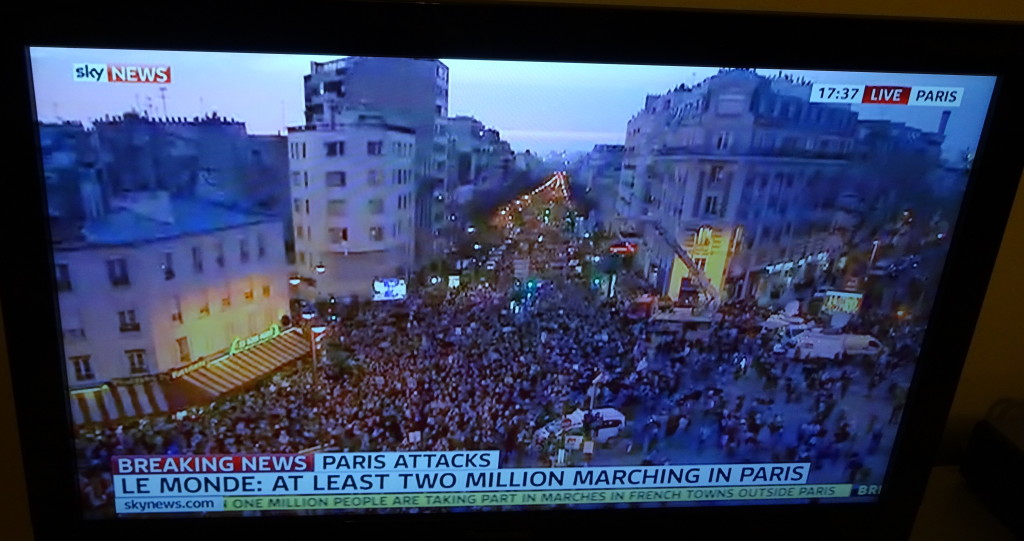 It was an extraordinary event, and being in Paris it felt important to be there. But twitter tells me that in today’s Telegraph there is an article that raises the issues that have to be borne in mind. The reactions for young people living in the area where the brothers lived, and why they feel as they do.
It was an extraordinary event, and being in Paris it felt important to be there. But twitter tells me that in today’s Telegraph there is an article that raises the issues that have to be borne in mind. The reactions for young people living in the area where the brothers lived, and why they feel as they do.


